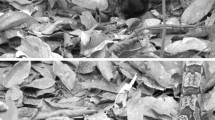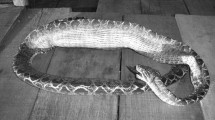Abstract
A juvenile common marmoset (Callithrix jacchus) was attacked by a whitetail lancehead viper (Bothrops leucurus) while playing with other group members close to the ground at a site in northeastern Brazil. The attack was almost immediately fatal, but the viper was unable to ingest the body of the marmoset. After approximately 10 min, during which it attempted to swallow the marmoset a number of times, the viper moved away, abandoning the body. While raptors are the principal predators of callitrichids, this record reinforces the relative vulnerability of these primates to snakes in comparison with other platyrrhines, although the small number of recorded events precludes a more definitive analysis of the phenomenon.
Similar content being viewed by others
Avoid common mistakes on your manuscript.
Introduction
Predation is a highly significant life history event, but has been observed only very rarely, if ever, in the majority of primate species (Stanford 2002; Miller and Treves 2011), impeding the more systematic analysis of the phenomenon and its frequency, or the behavioural or ecological factors that may influence the vulnerability of a primate to different predators. Given the paucity of records, the chronicling of events is essential for the establishment of a more reliable database for the analysis of predation patterns.
In a review of the evidence available for New World primates (Platyrrhini), Ferrari (2009) found that, while large raptors, such as harpy (Harpia harpyja) and Guianan crested eagles (Morphnus guianensis) were responsible for the majority of observed predation events, snakes may constitute a disproportionate threat to small-bodied platyrrhines, such as the marmosets and tamarins (Callitrichidae). A number of factors appear to contribute to the relatively reduced vulnerability of the callitrichids to raptors and carnivores, including their small size, agility and preference for dense vegetation. By contrast, the typical “sit-and-wait” foraging strategy of most snakes may be relatively more effective, even though such events are still rare overall. The present report describes an attack by a viper (Bothrops leucurus) on a juvenile common marmoset (Callithrix jacchus) at a site in northeastern Brazil. This event is discussed in the context of the evidence available on predation patterns in the callitrichids and other platyrrhine primates.
Methods
The event reported here was recorded at the Mata do Junco State Wildlife Refuge in Capela (10°31′S, 37°03′W), in the Brazilian state of Sergipe. This 895-hectare protected area was established specifically for the conservation of the local population of the endangered titi, Callicebus coimbrai, but it also supports a relatively large population of common marmosets (estimated to be approximately 117 individuals per square kilometre: Rocha 2011).
The behavioural observations of Callithrix jacchus were conducted in an ad libitum fashion (Altmann 1974). The events following the attack were recorded using the photographic mode of a Nokia mobile phone.
Results
At approximately 1400 hours on 3 January, 2011, a group of marmosets was observed in the vicinity of the reserve headquarters, where up to three juveniles were engaging in play behaviour on the trunk of a tree at less than 1 m in height, and occasionally coming down to the ground. The other members of the group (n = 6) were resting much higher up in the vegetation. One of the juveniles then emitted two loud distress vocalisations very rapidly, before falling silent. The remaining juveniles dispersed immediately up into the higher levels of the tree, and the other members of the group responded with excited chirps and movements, but none of the animals approached the scene of the attack.
A few seconds later, the juvenile—already inert—was found lying on the ground next to a whitetail lancehead viper (Bothrops leucurus) approximately 70 cm in length. The viper attempted to swallow the marmoset repeatedly over the subsequent 10 min (see video), but was unable to do so, given that the marmoset’s head was too large to pass through its mouth. The snake then moved away, abandoning the body, which was subsequently retrieved. Examination of the marmoset revealed a bite with two holes to the nape of the neck below the ear, which was surrounded by a large amount of saliva. The position of the bite may account for the relatively fast action of the venom, which likely penetrated the animal’s brain almost immediately. Assuming that the distress calls coincided with the moment of attack, the marmoset succumbed to the venom within a few seconds.
Discussion
Attacks by venomous snakes appear to represent an important selection pressure on terrestrial primates (Isbell 2006), and may also pose a significant threat to arboreal species (Foerster 2008). Snake attacks on platyrrhines appear to be relatively rare overall, although a disproportionate number of the published reports involve callitrichids (Ferrari 2009). Including the present record, 57.1% of snake attacks on platyrrhines (n = 7) were of callitrichids, while 33.3% observed raptor attacks (6 of 18) and only 14.3% of studies of nest remains (2 of 14) have involved these monkeys (although there may be a bias in the latter type of study towards larger bodied raptor species). The evidence on predation by carnivores and other mammals (direct observation and scat analyses) is less reliable, but it indicates relatively low rates of attack on callitrichids, similar to that of nest remains.
Observed attacks on callitrichids by snakes have involved both boids (Heymann 1987) and viperids (Corrêa and Coutinho 1997), while Kierulff et al. (2002) found a lion tamarin (Leontopithecus rosalia) in the belly of a boa constrictor. As these snakes will only capture live prey, it is reasonable to assume that this observation also represents a predation rather than a scavenging event. Boas preyed on lion tamarins on at least two other occasions (M.C. Kierulff, pers. comm.), although as all of these monkeys were equipped with radio transmitters, it is unclear whether such an apparently high rate of predation by these snakes is typical of the species under natural conditions.
As in the present study, the events recorded by Heymann (1987) and Corrêa and Coutinho (1997) involved animals close to the ground. Callitrichids typically exhibit highly cautious behaviour when faced with the need to come to the ground to cross gaps in the vegetation or retrieve fallen prey, for example—activities which may be relatively frequent in comparison with other platyrrhines, due to the preference of most callitrichid species for the lower strata of disturbed forest habitats (Ferrari 1993). While encounters with snakes may lead to a temporary increase in caution (Hankerson and Caine 2004), most attacks are probably unavoidable.
An additional factor may be the age of the animal. Both Ferrari and Lopes (1990) and Corrêa and Coutinho (1997) noted that the youngest members of their marmoset study groups would invariably approach snakes to much shorter distances than other group members during mobbing (by contrast, they react instinctively to raptor alarm calls virtually from birth). Juveniles and infants may also become relatively unvigilant during play behaviour, which may involve protracted periods of chasing, tagging, and wrestling, usually when adult group members are resting. This appeared to be the situation in the present case, and may be a common factor in other contexts (see Foerster 2008). While not all attacks may be fatal (Shahuano Tello et al. 2002), strikes by venomous snakes are likely to be, even if—as in the present study and Corrêa and Coutinho (1997)—the prey is not ingested.
Based on the review of Ferrari (2009), callitrichids appear to be relatively more vulnerable to attacks by snakes than other platyrrhines (even if more recent reports are taken into account: Bezerra et al. 2009; Lledo-Ferrer et al. 2009; Oliveira and Dietz 2011). However, in absolute terms, there are more published reports of raptor attacks, although this may be at least partly due to the greater visibility of this type of event (Ferrari 2009). A much larger number of records would obviously be needed to confirm any such conclusion.
As snakes are ambush predators (in contrast with raptors, which forage actively), attack rates may depend primarily on the probability of encounters, and this probability may vary according to the population densities of both snakes and callitrichids, rather than factors such as habitat structure and use (preference for lower strata and dense habitat), which may be more important to raptors. If there is a density-dependent relationship in the case of snakes, it may even be possible to develop crude estimators of infant mortality in different populations based on variations in population density.
References
Altmann J (1974) Observational study of behavior: sampling methods. Behaviour 49:227–267
Bezerra BM, Barnett AA, Souto A, Jones G (2009) Predation by the tayra on the common marmoset and the pale-throated three-toed sloth. J Ethol 27:91–96
Corrêa HKM, Coutinho PEG (1997) Fatal attack of a pit viper, Bothrops jararaca, on an infant buffy-tufted ear marmoset (Callithrix aurita). Primates 38:215–217
Ferrari SF (1993) Ecological differentiation in the Callitrichidae. In: Rylands AB (ed) Marmosets and tamarins: systematic, behavior, and ecology. Oxford University Press, Oxford, pp 314–328
Ferrari SF (2009) Predation risk and antipredator strategies. In: Garber PA, Estrada A, Bicca-Marques JC, Heymann EK, Strier KB (eds) South American primates: comparative perspectives in the study of behavior, ecology, and conservation. Springer, New York, pp 251–277
Ferrari SF, Lopes MA (1990) Predator avoidance behavior in the buffy-headed marmoset, Callithrix flaviceps. Primates 31:323–338
Foerster S (2008) Two incidents of venomous snakebite on juvenile blue and Sykes monkeys (Cercopithecus mitis stuhlmanni and C. m. albogularis). Primates 49:300–303
Hankerson SJ, Caine NG (2004) Pre-retirement predator encounters alter the morning behavior of captive marmosets (Callithrix geoffroyi). Am J Primatol 63:75–85
Heymann EW (1987) A field observation of predation on a moustached tamarin (Saguinus mystax) by an anaconda. Int J Primatol 8:193–195
Isbell LA (2006) Snakes as agents of evolutionary change in primate brains. J Hum Evol 51:1–35
Kierulff MC, Raboy BE, Oliveira PP, Miller K, Passos FC, Prado F (2002) Behavioral ecology of lion tamarins. In: Kleiman DG, Rylands AB (eds) Lion tamarins: biology and conservation. Smithsonian Institution Press, Washington, DC, pp 157–187
Lledo-Ferrer Y, Hidalgo A, Heymann EW, Pelaéz F (2009) Field observation of predation of a slate-colored hawk, Leucopternis schistacea, on a juvenile saddle-back tamarin, Saguinus fuscicollis. Neotrop Primates 16:82–84
Miller LE, Treves A (2011) Predation on primates: past studies, current challenges, and directions for future research. In: Campbell CJ, Fuentes A, MacKinnon KC, Bearder SK, Stumpf RM (eds) Primates in perspective. Oxford University Press, New York, pp 535–547
Oliveira LC, Dietz JM (2011) Predation risk and the interspecific association of two Brazilian Atlantic Forest primates in cabruca agroforest. Am J Primatol 73:1–9
Rocha JCAG (2011) Distribuição e densidade de populações de Callicebus coimbrai Kobayashi & Langguth 1999, na região do Refúgio de Vida Silvestre Mata do Junco, Sergipe (dissertation). Universidade Federal de Sergipe, São Cristóvão
Shahuano Tello SN, Huck M, Heymann EW (2002) Boa constrictor attack and successful defence in moustached tamarins, Saguinus mystax. Folia Primatol 73:146–148
Stanford CB (2002) Avoiding predators: expectations and evidence in primate antipredator behaviour. Int J Primatol 23:741–757
Acknowledgments
This study was supported by the Brazilian National Research Council, CNPq (project numbers 302747/2008-7, 476064/2008-2, and 374115/2010-9) and the Boticário Foundation (project no. 0846_20092). We thank Dr. Renato Faria for the identification of the snake, Valdineide Santana (IBAMA/SE) and the staff at Mata do Junco for their assistance with this research, as well as an anonymous reviewer for helpful comments on the original version of the manuscript.
Author information
Authors and Affiliations
Corresponding author
Electronic supplementary material
Below is the link to the electronic supplementary material.
Supplementary material 1 (AVI 21157 kb)
About this article
Cite this article
Ferrari, S.F., Beltrão-Mendes, R. Do snakes represent the principal predatory threat to callitrichids? Fatal attack of a viper (Bothrops leucurus) on a common marmoset (Callithrix jacchus) in the Atlantic Forest of the Brazilian Northeast. Primates 52, 207–209 (2011). https://doi.org/10.1007/s10329-011-0260-8
Received:
Accepted:
Published:
Issue Date:
DOI: https://doi.org/10.1007/s10329-011-0260-8




